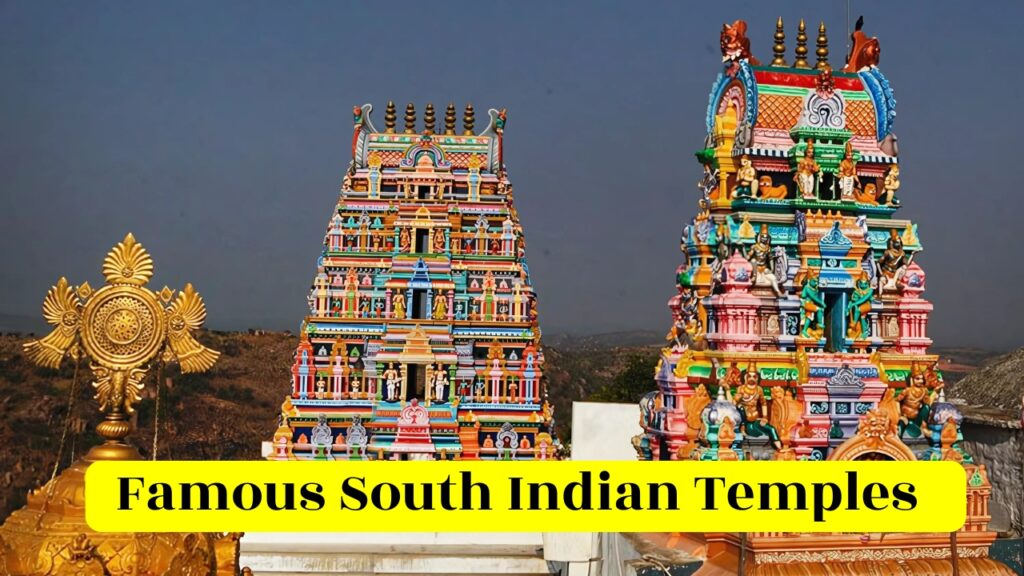India is known for its rich spiritual heritage, and the southern part of the country stands out for its grand temples, ancient traditions, and architectural brilliance. From intricately carved gopurams to centuries-old rituals, South Indian temples are not just places of worship—they are a testament to devotion, culture, and art.
If you are a spiritual traveler or a devotee looking for divine experiences, here are some famous South Indian temples that you must visit at least once in your lifetime.
Meenakshi Amman Temple – Madurai, Tamil Nadu
Dedicated to Goddess Meenakshi (a form of Parvati) and Lord Sundareswarar (a form of Shiva), the Meenakshi Temple is one of the oldest and most iconic temples in India. Located in the heart of Madurai, the temple is famous for its 12 towering gopurams adorned with thousands of colorful sculptures.
The temple complex is vast, and the Ayirakkal Mandapam (Hall of Thousand Pillars) is a major attraction. Devotees believe that a visit here brings marital happiness and family prosperity.
Tirupati Balaji Temple – Tirumala, Andhra Pradesh
One of the richest and most visited religious shrines in the world, the Tirupati Balaji Temple is dedicated to Lord Venkateswara (a form of Vishnu). Millions of pilgrims visit this temple every year to seek blessings and fulfill vows.
Devotees often offer their hair as a sign of surrender. The laddu prasadam and the spiritual aura make this temple a once-in-a-lifetime experience. Booking your darshan in advance is highly recommended due to the crowd.
Ramanathaswamy Temple – Rameswaram, Tamil Nadu
One of the Char Dham pilgrimage sites, the Ramanathaswamy Temple is deeply connected to Lord Rama. It is believed that Lord Rama built a Shiva Lingam here and worshipped it to absolve himself of the sin of killing Ravana.
The temple is known for having the longest corridor among all Hindu temples and for its 22 holy wells inside the premises, where devotees take a dip as a form of purification.
Srirangam Ranganathaswamy Temple – Trichy, Tamil Nadu
This massive temple complex is dedicated to Lord Ranganatha (Vishnu) and is one of the 108 Divya Desams (sacred abodes of Vishnu). Spread across 156 acres, the Srirangam Temple is often called the largest functioning temple in the world.
Its gopuram towers and richly decorated sanctum attract both devotees and architectural enthusiasts. The Vaikunta Ekadasi festival is celebrated with grandeur here.
Padmanabhaswamy Temple – Thiruvananthapuram, Kerala
Famous for its mysterious hidden vaults and immense wealth, the Padmanabhaswamy Temple is a unique blend of Dravidian and Kerala architecture. The temple is dedicated to Lord Vishnu in the reclining form known as Anantha Shayana.
Only Hindus are allowed inside, and a strict dress code is followed. The temple gained global attention after the discovery of massive hidden treasures in its underground chambers.
Murudeshwar Temple – Karnataka
Located on the coast of Karnataka, the Murudeshwar Temple is famous for having the second-tallest statue of Lord Shiva in the world, standing at a majestic 123 feet. The temple is built on a small hill called Kanduka Giri, surrounded by the Arabian Sea on three sides.
The scenic beauty combined with the spiritual vibe makes it a popular pilgrimage and tourist spot. Devotees believe that visiting Murudeshwar brings peace and strength.
Ayyappa Temple – Sabarimala, Kerala
Located amidst the dense forests of the Western Ghats, Sabarimala Temple is dedicated to Lord Ayyappa, the celibate deity. The temple is one of the largest annual pilgrimage destinations in the world, especially during the Mandala season (November to January).
Pilgrims undergo 41 days of fasting, celibacy, and devotion before making the trek to the temple, chanting “Swamiye Saranam Ayyappa.” The climb up the 18 sacred steps to reach the shrine is a test of devotion and discipline.
Brihadeeswarar Temple – Thanjavur, Tamil Nadu
Built over 1,000 years ago by Raja Raja Chola I, the Brihadeeswarar Temple, also known as the Big Temple, is a UNESCO World Heritage Site. It is dedicated to Lord Shiva and is considered a marvel of Chola architecture.
The temple’s Vimana (temple tower) is one of the tallest in India, and its massive Nandi (bull) statue carved from a single stone is awe-inspiring. Visiting this temple is like stepping into a glorious chapter of India’s past.
Kukke Subramanya Temple – Karnataka
Nestled in the lush greenery of the Western Ghats, Kukke Subramanya Temple is dedicated to Lord Subramanya, the protector of snakes. The temple is believed to be a powerful place for Naga Dosha Nivarana, and many devotees come here for relief from serpent-related doshas in their horoscope.
The calm surroundings and the sacred Kumaradhara River add to the divine atmosphere of the temple.
Sri Rajarajeswari Temple – Bangalore, Karnataka
Located in the serene outskirts of Bangalore, Sri Rajarajeswari Temple is a spiritual center dedicated to Goddess Rajarajeswari, a powerful form of Shakti. The temple is known for its disciplined rituals and serene energy.
It’s not as ancient as others, but its spiritual depth and the strong presence of divine feminine energy attract thousands of devotees each month.
Why South Indian Temples Are Unique
South Indian temples stand out for their towering gopurams, intricate carvings, and time-honored rituals. These temples are not only architectural wonders but also spiritual powerhouses that attract millions of devotees from across the world.
Many temples have daily pujas, special abhishekams, and grand festivals that keep age-old traditions alive. Each temple has its own mythology, rules, and dress codes, which devotees respectfully follow.
Tips for Devotees Planning a South India Temple Tour
Dress modestly and adhere to temple dress codes, especially in Tamil Nadu and Kerala. Remove footwear before entering temple premises and avoid carrying leather items. Try to visit during early morning hours to avoid rush and enjoy peaceful darshan. Book accommodations in advance, especially if visiting famous temples like Tirupati or Sabarimala. Many temples have limited mobile connectivity and strict timings, so plan accordingly.
Conclusion
South Indian temples are more than just places of worship—they are experiences that touch the soul. Each temple holds a unique story, a divine energy, and a connection to thousands of years of tradition. Whether you seek blessings, peace of mind, or a deep cultural immersion, a visit to these sacred shrines will remain etched in your memory forever.
Take a spiritual pause in your busy life and plan a journey to these divine destinations. They offer not just prayers but also perspective, peace, and purpose.


